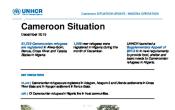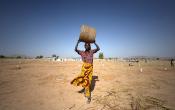Cameroon
Operation: Cameroon
Location
{"longitude":12,"latitude":5,"zoom_level":0,"iso_codes":"'CMR'"}
By clicking on the icons on the map, additional information is displayed.
The boundaries and names shown and the designations used on this map do not imply official endorsement or acceptance by the United Nations.
Key Figures
| 2020 planning figures | |
| 20,000 | refugees from CAR will get information on conditions of return and on return plans |
| 9,000 | IDPs will receive identity documents |
| 4,000 | refugees from CAR will receive production kits or inputs for agriculture, livestock and fisheries activities |
| 3,000 | stateless persons will be assisted with civil status registration or documentation |
| 28 | Nigerian refugee households will have access to alternative or renewable energy |
| 2018 year-end results | |
| 96% | of primary school-aged children were enrolled in primary education |
| 92% | of births were attended by skilled personnel |
| 80% | of SGBV survivors received appropriate support |
| 80% | of identified people of concern with disabilities received specific services |
| 54% | of leadership/management structures included active female participants |
| 20,000 | internally displaced households received emergency shelters in the South-West region |
Latest Updates and Related Links
People of Concern
52%
Increase in
2019
2019
| 2019 | 1,714,415 |
| 2018 | 1,124,620 |
| 2017 | 598,570 |

[["Refugees",406260],["Asylum-seekers",9948],["IDPs",950263],["Returned IDPs",347923],["Returned refugees",1],["Others of concern",20]]
Loading ...
Cameroon
< Back
2019
{"categories":[2015,2016,2017,2018,2019,2020],"budget":[114.697643602,98.624602509,94.244828756,86.91180626,90.19158292,99.76177489],"expenditure":[50.71501571,50.50994132,48.4210928,46.14392993,45.67232471,null]}
{"categories":[2015,2016,2017,2018,2019,2020],"p1":[107.653576378,89.476459699,87.796062136,74.15877144,68.04329663,73.53833169],"p2":[0.843987224,1.885381,1.14850401,0.37553251,0.47828244,0.86122901],"p3":[null,null,null,null,null,null],"p4":[6.20008,7.26276181,5.30026261,12.37750231,21.67000385,25.36221419]}
{"categories":[2015,2016,2017,2018,2019,2020],"p1":[45.95148629,46.39734147,46.55642961,41.88934566,36.37272013,null],"p2":[0.207295,1.36677006,0.31050242,0.2846358,0.10304112,null],"p3":[null,null,null,null,null,null],"p4":[4.55623442,2.74582979,1.55416077,3.96994847,9.19656346,null]}
Loading ...
CHOOSE A YEAR
- 2014
- 2015
- 2016
- 2017
- 2018
- 2019
- 2020
Year-end Overview
Working environment
The operational environment in Cameroon is shaped by the ongoing instability in neighbouring countries and, therefore, the increased refugee influx to Cameroon is expected to continue in 2019. However, following return intention surveys carried out in June 2018 in the sites and host areas of refugees from the Central African Republic, and upon seeing relative improvement in certain areas of origin along the border with Cameroon, possible returns are now being envisaged.Cameroon has a long history of providing asylum to refugees. There are some 700,000 people of concern to UNHCR in Cameroon, among whom 323,000 refugees, including Nigerians in the Far North, Central Africans in the Eastern border regions, and refugees of different nationalities in urban centres. The presence of large numbers of refugees is exacerbating pre-existing infrastructural challenges, resulting in increased fragility and potential risk to social cohesion in affected areas; a risk amplified by increasing pressure on the natural environment and scarce natural resources. Access to basic services is limited, rates of identity documentation and birth certificates are lower than national averages and the refugee-hosting regions (East, Adamaoua, North and the Far North) are largely isolated from the rest of the country.
The operation will continue to promote and build on effective partnerships with stakeholders as identified in the multi-year, multi-partner (MYMP) 2018-2020 strategy. The development of the 2019 partnerships and protection strategy was attended by 96 participants of 53 diverse organisations including key refugee representatives, as well as members of the Government, donor agencies, current implementing partners and operational partners, both at national and international level.
UNHCR will continue to coordinate refugee issues with partners at the different coordination platforms including the UNCT, UNPMT, multi-sectoral teams within the OCHA coordination mechanisms. UNHCR leads the protection as well as the shelter and NFI sector within the country multisector working groups and is an active member of the cash working group.
UNHCR will continue to participate in the UNDAF strategy and ensure inclusion of refugee interests. In this light, the operation will ensure the operationalisation of the Humanitarian Response Plan, mainstreaming of refugee chapter in the Humanitarian Needs Overview, and participate in joint assessment and funding appeals involving internally displaced people and other people of concern.
Key priorities
In 2019, UNHCR will focus on:- reinforcing and diversifying partnerships with development actors, international financial institutions —including the World Bank and the African Development Bank— and private sector actors, and most importantly, to deepen its engagement with government counterparts regarding the management of all refugee-related matters.
- completing the capacity building of the Governement in order to handover to the leadership and the ownership of RSD, registration and documentation process.
- empowering and including refugees and other people of concern in the programme management process and provide protection and multi-sector assistance taking into account the age, gender and diversity specificities. It will enhance the implementation of cash-based interventions in sectors and areas where protection risks are minimal and opportunities exist, such as education and livelihood.
- strengthening the strategic alliance with the World Bank in Cameroon and ensure the expected allocation of funds for refugees and refugee-hosting areas under the International Development Association plan for 2019-2021 is in line with UNHCR’s humanitarian efforts in the country. UNHCR will also work to maintain its partnership with the African Development Bank that has contributed funds to activities in 2015-2017 for the humanitarian response of CAR and Nigerian refugees.























